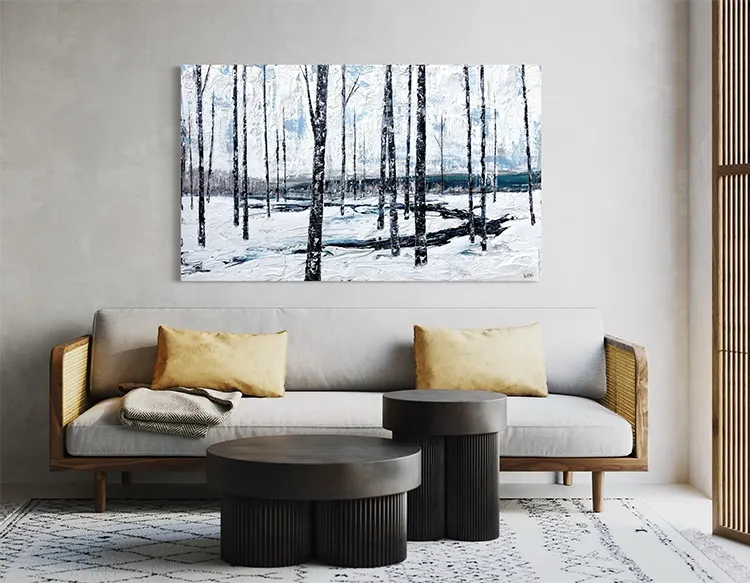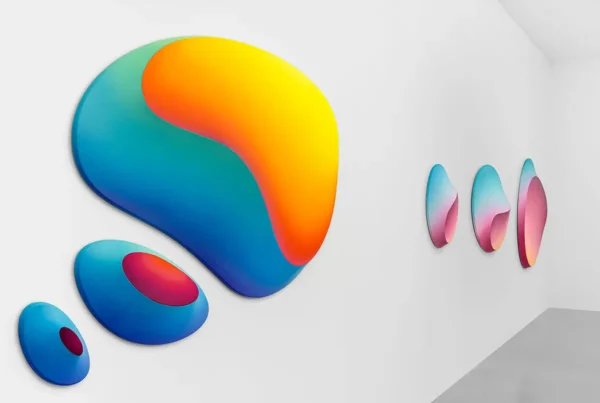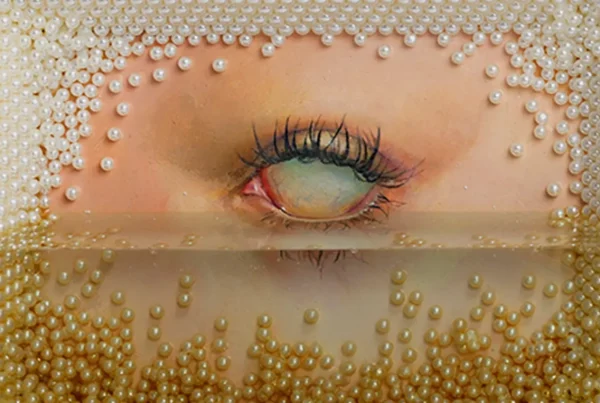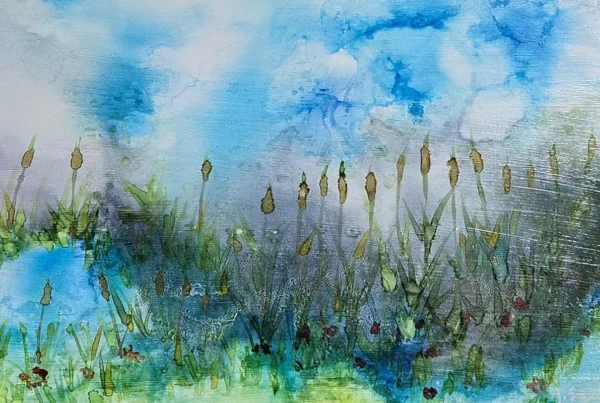Banner Image:
A Downtown Moderne Icescape
Oil on canvas, 75 x 47 in.
2023 | LUPRI
“I have been an artist all my life and knew the feeling when it hits you properly—it has always been more of a need than a want.”
A Life Shaped by Sound, Landscape, and Myth
Matthias Lupri’s path to becoming a visual artist is anything but conventional. Born in Germany and raised in the untamed foothills of the Canadian Rockies, his early years were shaped by an immersion in nature’s vastness and mystery. That sense of wonder carried him through a dynamic career in music, leading him to Boston, where he studied and performed as a jazz musician for over three decades. His compositions and performances reflected his deep fascination with improvisation, emotion, and abstract storytelling—elements that would later resurface in his painting practice.
While his primary career revolved around music, Lupri’s creative spirit was never confined to a single medium. His curiosity led him to experiment with photography, filmmaking, and writing, but none of these forms provided the artistic fulfillment he sought. It wasn’t until he picked up a palette knife and applied oil paint to canvas that he found an immediate and undeniable connection. The tactile, expressive nature of the technique resonated with his artistic instincts in a way nothing else had. What started as an experiment soon became his dominant mode of creative expression, marking a profound shift in his artistic journey.
Now, as a painter, Lupri translates his lifelong inspirations—mythology, nature, dreams, and movement—onto large-scale canvases. His works, some as expansive as ten feet across, embrace the energy and unpredictability of abstraction while maintaining an internal rhythm, much like the improvisational nature of jazz. His art is not merely an aesthetic pursuit but an exploration of subconscious narratives, channeling the same intuitive force that once drove his music.
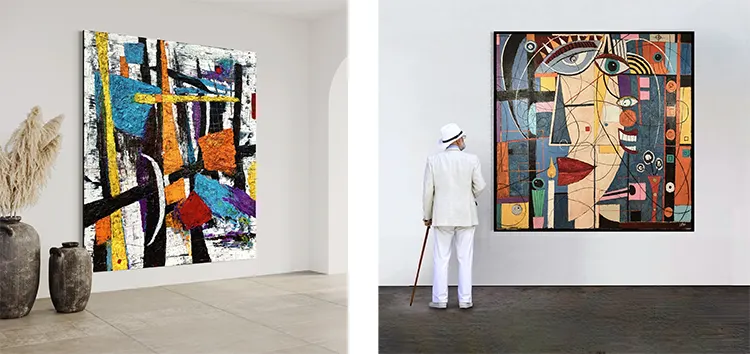
Tanglewood Portrait
Oil on canvas, 84 x 72 in.
2022 | LUPRI
Camilia Morning After
Oil on canvas, 72 x 72 in.
2024 | LUPRI
Matthias Lupri: Discovering a New Language Through Paint
The transition from jazz to painting was not a sudden decision but a gradual realization that his artistic essence needed a new outlet. After stepping away from music, Lupri explored various creative disciplines, but none provided the depth and visceral connection he longed for. It wasn’t until he started painting that he recognized the same sense of immediacy and emotional intensity he once found in performance. The moment he switched from brushes to palette knives, he discovered a raw, physical approach to painting that felt natural and instinctive.
In the early days of his career as a painter, Lupri focused on simply getting his work out into the world. He exhibited in Boston, entering galleries and shows wherever possible, allowing his art to speak for itself. As his distinctive style developed, his paintings began to resonate with collectors, leading to international sales and recognition. Over the past eight years, he has firmly established himself as a professional artist, proving that reinvention is not just possible but essential for creative growth.
Lupri’s approach to painting mirrors his background in jazz—spontaneous, fluid, and deeply rooted in personal expression. He embraces the unpredictability of each piece, letting intuition guide his movements rather than following rigid structures. Just as a musician trusts the flow of improvisation, he trusts the act of painting to reveal its own story. This philosophy has allowed him to carve out a space in the contemporary art world that is uniquely his own, blending abstraction with introspection in a way that feels both deeply personal and universally resonant.
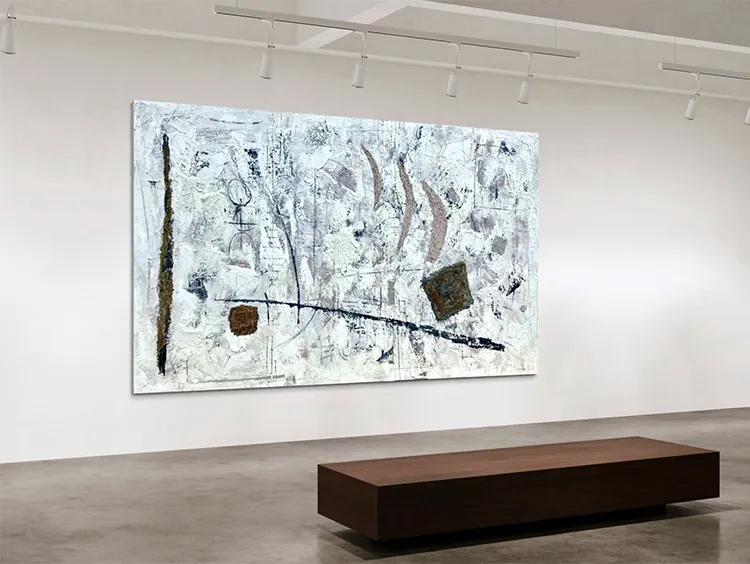
Semblance Three Moons
Oil on canvas, 120 x 72 in.
2023 | LUPRI
Navigating the Unconscious: Themes and Influences in Lupri’s Work
Lupri’s artistic style defies strict categorization, drawing from Abstract Expressionism while incorporating elements of Impressionism, Minimalism, and architectural abstraction. His paintings shift between pure abstraction and figurative elements, exploring landscapes, cityscapes, and dreamlike imagery. What unites these varying themes is his technique—loose, gestural, and rich with texture, creating a dynamic interplay between control and chaos. His process is intuitive, responding to both his internal world and the unconscious energies that surface during creation.
One of Lupri’s most significant influences is Carl Jung, whose theories on the collective unconscious and archetypal symbolism deeply resonate with his artistic philosophy. Without initially realizing it, Lupri had been channeling similar ideas in his work, using mythology and subconscious imagery to construct visual narratives. His paintings often explore themes of balance, duality, and the unseen forces that shape human experience. In his 2015 piece Daemons of Inner Primordial Mirror (72×48”), he examines these concepts through an abstract lens, merging cosmic themes with mythological undertones to bridge the conscious and unconscious realms.
Beyond Jung, Lupri’s inspirations span a wide range of artists who have pushed the boundaries of abstraction. Figures like Anselm Kiefer, Picasso, Modigliani, Pollock, Joan Mitchell, Richter, and de Kooning have all played a role in shaping his visual language. Each of these artists shares a commitment to raw expression, layering, and the physicality of paint—qualities that resonate deeply with Lupri’s own approach. By studying their work, he has refined his ability to convey emotion and narrative through abstraction, ensuring that each piece is not just a painting but a psychological exploration.
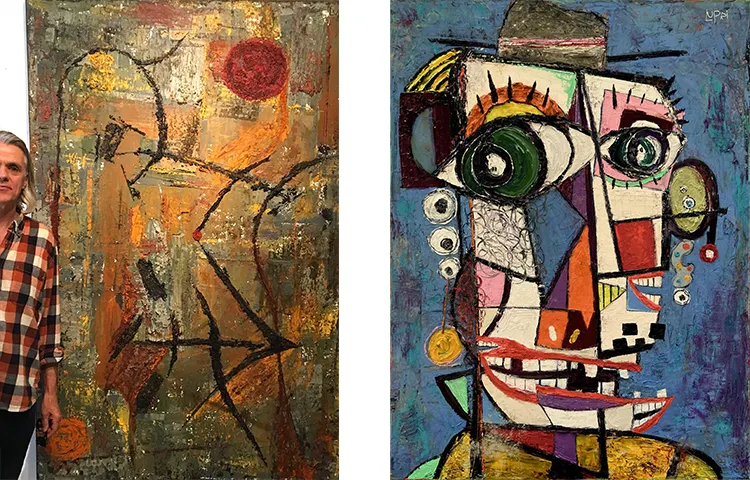
Daemons of Inner Primordial Mirror with LUPRI
Oil on canvas, 72 x 48 in.
2015 | LUPRI
Cool Cat Laphroaig
Oil on canvas, 48 x 36 in.
2024 | LUPRI
Matthias Lupri: The Ritual of Creation and Future Aspirations
Lupri’s studio practice is built around routine and discipline, allowing him to enter a state of creative immersion with minimal distraction. His workspace is simple—just a room in his home with controlled lighting and a closed door. Unlike many artists who work alongside music, he prefers silence, allowing the rhythms of his past life in jazz to emerge naturally onto the canvas. He paints every day, breaking his sessions into focused bursts of 20-30 minutes, punctuated by brief pauses to reset his concentration before diving back in. This cyclical approach mirrors the improvisational nature of his art, ensuring that each piece develops organically without being forced.
His choice of materials further enhances his connection to the work. Though his journey with oil paint began by chance—guided by an art store employee’s recommendation—it has since become an integral part of his process. The slow-drying nature of oil allows him to build layers, rework textures, and let the painting evolve over time. Combined with his use of palette knives, charcoal, and wax, his technique creates surfaces that are rich with depth and movement, capturing both the physical act of painting and the emotions embedded within it.
While painting remains his primary focus, Lupri has long envisioned an ambitious project that would integrate multiple artistic disciplines. His dream is to create an art film that captures the inner world of an artist—a deeply immersive, almost surreal narrative where his paintings, original music, and personal experiences intertwine. Though the idea remains in the early stages, it speaks to his ever-expanding artistic vision, one that refuses to be confined to a single form of expression. Whether through paint, film, or another unforeseen medium, Lupri continues to push the boundaries of his creativity, proving that art, like life, is an ever-evolving journey.
